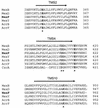Amino acid residues essential for function of the MexF efflux pump protein of Pseudomonas aeruginosa
- PMID: 12069970
- PMCID: PMC127300
- DOI: 10.1128/AAC.46.7.2169-2173.2002
Amino acid residues essential for function of the MexF efflux pump protein of Pseudomonas aeruginosa
Abstract
At least four broad-spectrum efflux pumps (Mex) are involved in elevated intrinsic antibiotic resistance as well as in acquired multidrug resistance in Pseudomonas aeruginosa. Substrate specificity of the Mex pumps has been shown to be determined by the cytoplasmic membrane component (MexB, MexD, MexF, and MexY) of the tripartite efflux pump system. Alignment of their amino acid sequences with those of the homologous AcrB and AcrD pump proteins of Escherichia coli showed conservation of five charged amino acid residues located in or next to transmembrane segments (TMS). These residues were mutated in the MexF gene by site-directed mutagenesis and replaced by residues of opposite or neutral charge. MexF proteins containing combined D410A and A411G substitutions located in TMS4 were completely inactive. Similarly, the substitutions E417K (next to TMS4) and K951E (TMS10) also caused loss of activity towards all tested antibiotics. The substitution E349K in TMS2 resulted in a MexF mutant protein which was unable to transport trimethoprim and quinolones but retained partial activity for the transport of chloramphenicol. All mutated MexF proteins were expressed at comparable levels when tested by Western blot analysis. It is concluded that charged residues located in or close to TMS are essential for proper function of MexF.
Figures


References
-
- Goldberg, M., T. Pribyl, S. Juhnke, and D. H. Nies. 1999. Energetics and topology of CzcA, a cation/proton antiporter of the resistance-nodulation-cell division protein family. J. Biol. Chem. 274:26065-26070. - PubMed
Publication types
MeSH terms
Substances
LinkOut - more resources
Full Text Sources
Other Literature Sources

